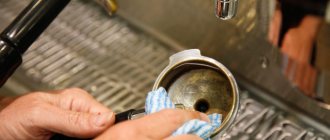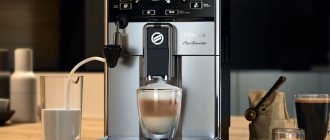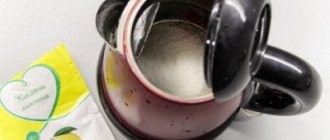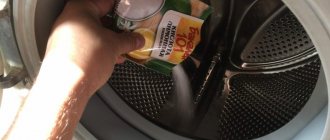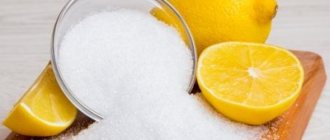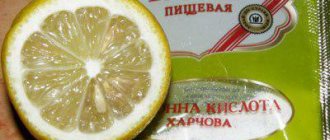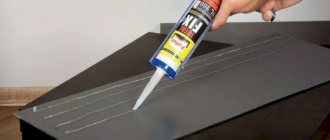Coffee machines have become firmly established in everyday life. They are used in catering, in office kitchens, at home, i.e. almost everywhere. These devices automated all stages of preparing coffee drinks, while ensuring high taste characteristics of the products. But as usual, some problems arise during their operation. One of them is the need to periodically descale the coffee machine or, to use another term, decalcify the coffee machine. This action includes washing machine parts, descaling, etc. All this will be the topic of this article.
What is decalcification of a coffee machine
Drinking water always contains a certain amount of calcium salts. There are more of them in hard water, less in soft water, but in any case they are present. During the operation of the coffee machine, these salts are gradually deposited on its various elements in contact with the aquatic environment, and over time they form plaque (scale). Because of this hardened deposit, the machine begins to work worse, and the coffee develops an off-flavor. There is only one way out of the described situation - cleaning the coffee machine from accumulated deposits, also known as decalcification.
The higher the water hardness, the more deposits will form in the coffee machine, and the more often you will have to clean it. In some cases you have to do this monthly. Therefore, it is best to use soft bottled water to make coffee; it also has a positive effect on the taste of this drink.
Causes of scale
The cause of limescale is the hardness salts CaCO3 and MgCO3 (salts of rare earth metals calcium and magnesium) that are poorly soluble in water. These compounds are formed by heating bicarbonates Ca(HCO3)2 and Mg(HCO3)2, which are part of natural water and decompose at temperatures above +40 ºС.
The reaction occurs:
Ca(HCO3)2 = CaCO3 + H2O + CO2;
Mg(HCO3)2 = MgCO3 + H2O + CO2.
If you install an ion exchange filter or a device that magnetizes water on the incoming water pipe, you can significantly reduce the deposition of hardness salts on heaters and extend the service life of not only the coffee maker, but also the boiler, kettle, washing machine and dishwasher.
How scale appears
Even if you purify water with water filters, a certain amount of salts remains in it. During the process of brewing coffee, the water heats up, the salts form a solid sediment, which is deposited wherever possible. In addition to calcium salts, the oil released during the heat treatment of coffee beans contributes to the formation of various layers. It settles in the same way and thickens over time. The resulting scale is unpleasant because it negatively affects the performance of the machine, reduces its service life, and also negatively affects the taste of the coffee. To get rid of scale, specialized products are used; simply washing the coffee machine with water does not help.
Signs of a dirty coffee maker
If water with salts is used, scale will inevitably form. It appears on simple drip devices, and on capsule or even horn devices. What influences the formation of a large amount of scale: the shape of the internal parts of the device. Salt particles clog parts as water passes through.
Simple devices are not equipped with special indicators that allow you to recognize a problem, so you will have to focus on certain symptoms of a future problem:
- The boiling time for water has increased - preparing a drink takes many times longer than before.
- If the main tube is clogged, the stream of coffee decreases, so it takes longer to fill the cup.
- Along with the deterioration of the device’s performance, the taste of the finished coffee also deteriorates.
- The coffee maker makes new and uncharacteristic sounds - it hums loudly.
- Another important sign is that there is sediment left at the bottom of the cup: not coffee, but sediment that tastes unpleasant.
For you:
Pump for pumping out sewerage in a coffee shop
A faulty device consumes more electricity, so a high light bill can also reveal hidden problems with the device. Heating elements are most susceptible to plaque formation - in capsule, carob and boiler devices. If the device has a thermoblock, water does not stagnate in it - it breaks less often.
If the causes of the problems are identified, special cleaning is carried out to remove scale. The sediment itself will not disappear, but the operation of the coffee maker will only worsen. There are 2 options available to correct the problem - self-cleaning or work carried out by a repairman.
Why descale
As various deposits accumulate in the components of the coffee machine, the mode of preparing the drink begins to be disrupted, in particular, the temperature of its brewing decreases. In addition, the machine begins to make noise during operation and operate intermittently. The yield of the finished drink is reduced, and its taste usually deteriorates noticeably. Comprehensive cleaning of the coffee machine, including removal of oils and descaling, brings its operating parameters back to normal, which has a positive effect on the quality of the prepared coffee. In addition, the yield of the finished drink increases, noise during operation disappears, and in general the service life of this device increases.
How often should I clean?
The frequency of cleaning depends on two parameters:
- how hard water you use;
- Do you brew a lot of coffee?
With high hardness, limescale deposits may appear after using 60 liters of water, which approximately corresponds to 300 cups of coffee.
The Polaris PACM 2060AC coffee machine has a reminder function about the need to decalcify. In the settings, you can specify the hardness of the water used, after which reminders that you need to clean will appear automatically.
What products should I use to descale coffee machines?
Manufacturers of household appliances, such as DeLonghi, Dolce Gusto, Saeco, Philips and others offer their own branded products for descaling coffee machines. In principle, all these liquids and tablets can be used quite effectively to clean any model. In addition, there are similar products on sale, but not tied to any brand. Products for removing all kinds of hardened deposits can be produced in the form of washing liquids, as well as in the form of powders or tablets. In addition, you can wash the car with a self-prepared solution of citric acid.
Reading with the user manual
The best way to understand how to wash a coffee machine is to read its instructions. Manufacturers describe in detail all recommended actions regarding the care of this type of equipment. Each coffee machine has its own structure and characteristics, and its care may differ from other models.
Thus, different types of filters used in a built-in coffee grinder require different maintenance:
- -paper. It is considered the most correct and hygienic, but it must be changed every day;
- - golden. A filter that is coated with titanium nitride and does not require replacement throughout the entire service life of the equipment;
- -nylon. The most common type of filter. It is designed for 60 brews, after which it requires replacement.
How often should you clean your coffee machine?
In principle, the frequency of cleaning this device mainly depends on the quality of the water. If hard water is used, it is recommended to clean it at least every month and a half. For soft water, this period increases to six months. You can wash the machine, focusing on external signs - an indication of the device itself or a change in the nature of its operation. This will be discussed in more detail below.
In addition to decalcification, you need to regularly clean the cappuccino machine - a device for frothing milk. It is recommended to rinse this unit with bottled water after each use, as... milk residues are a favorable environment for the proliferation of microorganisms, including pathogens. In addition, without rinsing, sediment accumulates in the cappuccino maker over time, and this unit stops frothing milk. In this case, it will have to be washed with a special washing liquid.
How to tidy up the milk circuit of a coffee machine
This topic is especially relevant for owners of coffee machines with automatic cappuccino makers. By the way, any device needs to be cleaned, both with a discharge pipe and a built-in jug. Here, timeliness of actions and reliance on instructions are also important.
As a rule, manufacturers indicate the need for periodic maintenance. In fact, cappuccino makers and milk jugs must be cleaned selectively and always on a regular basis . Washing is carried out under running water without the use of chemicals. If the machine has a cappuccino maker in the form of a tube, it is immediately cleaned under the tap and put back.
The automatic cappuccino maker can be cleaned as follows: replace the milk container with a water container. The milk supply is activated. If cleaning is carried out quickly (the system is not contaminated with dried residues), it is enough to drive 50 ml of water.
If you skipped washing and the milk tract is clogged and does not create foam well, you will have to use a special preparation . Here again, manufacturers help out by offering a lot of products with a significant price range. But the situation remains the same - in an automatic coffee machine you can use any product designed to clean the milk system. The minimum price tag starts from 320 rubles for 250 ml (again, Melitta dumps).
I advise you to wash all parts of automatic cappuccino makers in the dishwasher or under the tap at the end of 3-4 days of operation . This way, this unit will never need chemicals and you can save on cleaning. Don't forget to do a quick steam rinse after each cappuccino.
If you are too lazy to deal with this issue, immediately purchase full automation, where the cleaning cycle of each unit is started with one button.
What can be used to clean the milk system
During intensive use, a number of specialized drugs are used:
- Liquids for cleaning the milk system - effectively remove milk residues. Used in accordance with the equipment manufacturer's instructions. As a rule, 15-25 ml are used daily;
- liquids for cleaning cappuccino makers;
- tablets for cleaning the milk system.
How to know when it's time to descale
Before you clean your coffee machine from any accumulated deposits, you need to understand whether it needs cleaning. Many models are equipped with an indication system that signals the need for a decalcification procedure. It should be understood that such systems do not determine water hardness and the amount of accumulated sediment using any sensors. They work on a very simple principle. The machine program contains the number of brewed portions of the drink (for example, 230 cups). After this limit is exhausted, the device requires decalcification, regardless of whether it is really necessary or not. In fact, the machine signals that maintenance is needed.
Some models allow the user to enter water hardness data manually. The delivery set also includes tests that allow you to determine the degree of hardness. In this case, the system gives more adequate signals about the need for decalcification.
You can also judge by eye whether your car needs to be cleaned. The following signs indicate that it is dirty and needs decalcification:
- the device is too noisy during operation, makes uncharacteristic sounds;
- the coffee stream at the exit becomes noticeably thinner than it was initially;
- ready-made coffee loses strength;
- the usual taste of the drink changes;
- the portion of the prepared drink is reduced;
- There is a noticeable sediment in the coffee cup.
All of the above clearly indicates that you cannot delay descaling the system. Otherwise, the device may fail in the near future.
Before starting the cleaning procedure, it is recommended to read the operating instructions for the coffee machine. It should describe how to carry out this procedure, and nuances specific to this particular model may be indicated.
How to recognize the need for a procedure?
Usually, you don’t have to wonder if your coffee machine is contaminated with scale and coffee oils. The device lights up. Can appear:
- Loud sounds when brewing coffee. If there is a large amount of contaminants, it is more difficult for the pump to move water, and it begins to operate noisier.
- Stale taste of the drink. Scale and coffee oils deposited on parts greatly degrade the taste of coffee.
- Reducing pressure. If the coffee machine is very dirty, nothing but steam will enter the cup.
- Whitish sediment in the cup. Represents scale particles. Drinking them is not only unpleasant, but also harmful to health.
- Poor performance of the cappuccino maker. A dirty coffee machine is not capable of brewing cappuccino with fluffy foam. The foam will take a long time to whip up, and the output will be large, completely unappetizing bubbles.
What you need to clean your coffee machine
Before you descale your coffee machine, you need to decide on the cleaning method and select a substance that will remove all these fossilized deposits. This may be a branded product offered by household appliance manufacturers, or a product not associated with any brand. Branded products tend to be more expensive than others. In some cases, they are fully optimized for devices of certain brands, and manufacturers guarantee their effectiveness. The products themselves are available in a variety of forms. These can be liquids, powders or tablets. They are used according to the instructions.
How to descale a coffee machine: step-by-step instructions
The procedure for cleaning the coffee machine from various types of deposits on its internal parts consists of the following steps:
- First, it is recommended to clean all accessible components of the machine from coffee residues, empty the water from the water compartment, and remove waste from the tray;
- then, strictly following the instructions, you need to dissolve the cleaning agent in water, and in the specified proportion;
- the resulting solution is poured into the water compartment;
- the drink preparation mode is turned on and several portions of liquid are drained at intervals of 5-6 minutes until the water compartment is empty;
- the water tank is rinsed and filled with clean water;
- the drink preparation mode is turned on again;
- again, the water in the compartment is completely replaced and the operating mode of the machine is turned on, after which it is considered cleaned.
Models with a spray or carob type can be cleaned without adding coffee. Some models are equipped with a built-in automatic cleaning mode. In this case, removal of deposits is carried out using this mode and following the user instructions.
If the brewing unit in the coffee machine is clogged (cleaning the hydraulic system)
An automatic bean-based coffee machine is always equipped with a brewing unit. In capsule devices, this functionality is carried by the capsules themselves, in carob devices - by the horn. Over the course of operation, the unit becomes overgrown with coffee oils and particles of ground powder.
The type of brewing unit can be:
- non-removable (built-in);
- removable.
Cleaning of one type or another has fundamental differences. The user must remove the removable device himself, rinse it under running water, dry it and install it back . The frequency of this operation is once every 1-3 weeks, depending on the intensity of use. For example, if the machine is in the office and dispenses about 50-100 cups every day, it is better to wash the teapot at the end of the working day.
In addition, for every 300-500 cups, a kind of spring cleaning is carried out . The removable block and water path are cleaned using special products. Manufacturers have tried to ensure that there are plenty of cleaning tablets.
If we talk about built-in brewing devices, of which there are plenty in Krups and Jura coffee machines, the machine itself sends a request for cleaning. In this case, the same tablets are used. I note that for such blocks this operation is vital; if this is neglected, the equipment will quickly turn into trash.
Choosing cleaning tablets
Almost all tablets for cleaning brewing units are produced by coffee machine manufacturers. The companies Bosch (10 pcs/750 r) and Melita (4 pcs/380 r) have especially distinguished themselves in this regard - they are the ones who will help you save money. I would like to note that products from such giants as Krups and Jura are on sale, which are 15-20% more expensive. You will hear that each device can only use the native drug, but in reality this is not true. The composition of the tablets is almost identical and any option can be used.
How it works
Detailed instructions for cleaning the brewing unit of the device should be contained in the instructions. However, not all manufacturers consider it necessary to cover this point. It happens that there is automatic decalcification, but no removal of coffee fats . This can be seen on Delonghi, Saeco, Gaggia, Spidem slot machines.
If you are faced with just such a problem, cleaning in pour-type machines is implemented as follows:
- coffee is removed from the equipment;
- The tablet is placed in the compartment for ground coffee or 3 g of cleaning powder is taken. A spill requires 2 liters of water;
- the “ground coffee” preparation mode is activated (the names may be different, but the meaning is the same);
- A cup is placed under the dispensing spout;
- Espresso brewing starts. In the settings you should set the largest volume of the drink;
- water flows into the cup, which should be poured into the sink;
- after completing the cooking cycle, leave the machine for 30 minutes;
- then rinse with clean water.
*Do not place the cleaning product in the coffee grinder or in the water container!
The correct cleaning sequence for espresso machines is as follows:
- A blind filter is installed in the espresso machine. 3 g of powder is added. This is about half a teaspoon;
- the portafilter is inserted into the group;
- the spill cycle starts for 10 s;
- work is interrupted for 10 s;
- this sequence is repeated 5 times;
- the portafilter is removed and washed;
- inserted back, 4-5 cycles of spilling without cleaning powder are passed;
- the first portion of espresso is drained;
- the metal parts of the portafilter and filters are soaked in a solution of cleaning powder (1 l/6 g);
- the parts are washed with warm running water and installed in place.
The entire process of removing coffee fats takes 10-15 minutes . If the coffee machine has automatic cleaning - CLEAN - in different models it is started with different buttons, which should be looked at in the instruction manual. There is also a special compartment for cleaning products. When the automatic program is running, you should monitor the cleaning process, the indication shown by the device, follow commands - add water, press a button, empty containers, etc.
*you can additionally remove the coffee supply device (dispenser) and wash it manually. If non-native tablets are used and they do not fit into the compartment, they should be crushed.
Additional nuances
Not all equipment can work with both beans and ground coffee (there are models that do not have a compartment for ready-made coffee powder). Plus, some manufacturers equip these bins with sensors, so if there is no product inside the coffee machine, they refuse to prepare a drink. All this makes cleaning the brewer more difficult.
In this case, you should periodically wash the block under running water, dry it and install it in place. The coffee oil tablet is placed in the brewer, the machine is turned on and cleaning begins . After this, forced flushing of the coffee tract is required, which is started by a button or a separate item in the menu. There may be part of the tablet left in the waste compartment that has not had time to dissolve.
Table-review of purchased decalcification products
There are many products on sale that remove scale from various types of coffee machines. For ease of comparison, the characteristics of some common tools are summarized in a general table.
| Name | Type | Peculiarities | Package volume |
| Top house | Liquid or tablets | Manufactured taking into account the recommendations of manufacturers, made in Germany | 0.25 liters of liquid for two uses or 8 tablets per pack for 8 uses |
| Topper 3006 | Liquid | Manufactured taking into account the recommendations of manufacturers, made in Germany | 0.25 l for two uses |
| DeLonghi DLSC500 | Liquid | Optimized for DeLonghi equipment, but also suitable for other brands, made in Italy | 0.5 l for 4 uses |
| Philips-Saeco CA6700/00 | Liquid | It has a soft action, protects against corrosion, made in Germany | 0.25 l for one cleaning cycle |
| Melitta | Liquid or powder | Features a mild action, made in Germany | 0.25 l liquid for five cleanings or 2 sachets for two uses |
| Bosch TCZ8002 | Pills | Instant tablets, made in Germany | The package contains three tablets for three uses |
| Filtero | Pills | Instant tablets, made in Germany | Pack contains 4 tablets for four uses |
Top House
Topper 3006
DeLonghi DLSC500
Philips-Saeco CA6700/00
Melitta
Bosch TCZ8002
Filtero
Is it worth using traditional methods?
When deciding how to clean a coffee machine, you should remember the so-called traditional methods for descaling at home. In principle, you can save a little and clean your car from various salt and other deposits with such cheap and affordable products as vinegar or citric acid, since they are almost always available in the kitchen. In addition, branded liquids or tablets contain the same citric acid. But at the same time, unlike industrial products, it is easier to make a mistake in the proportions and not get the desired result, or even harm the machine. Therefore, if possible, it is better not to experiment with such products. Although it is useful to understand how to use them, so that in case of emergency (for example, if it is impossible to buy a special product), you can use them effectively without damaging the car.
Features of cleaning different types of coffee makers
Depending on the type of coffee maker, descaling the device varies slightly, although the principle of operation remains the same, as does the procedure for removing plaque.
Drip coffee maker
It is recommended to clean drip devices from plaque at least once a month. The descaling process follows the general algorithm for coffee makers with a self-cleaning mode or, if such a function does not exist, according to the instructions for each folk or professional remedy used (tablets, powders, etc.). Particular attention should be paid to the water filter, which is recommended to be treated with a brush (or a toothbrush).
Carob coffee maker
When descaling a carob coffee maker, the general principles of descaling apply. However, attention is paid to the holder, which must be removed and washed thoroughly, removing any existing deposits with a sponge. When removing and disassembling the horn, you must disconnect the device from the power supply to avoid electric shock. It is recommended to clean the device 1-2 times a month.
Cleaning the coffee machine with folk remedies
As mentioned above, to clean a coffee machine from coffee oils and scale at home, you can use such common products as vinegar and citric acid, although in any case it is better to use specialized industrial products, which, by the way, is what repair and maintenance specialists insist on such technology. Let's look at the features of using both products.
When using filtered tap water, the intensity of the formation of various hardened deposits decreases, but does not stop. The best option is to use soft bottled water.
How to clean a coffee machine with vinegar
First you need to prepare a cleaning solution. To prepare it, you need to mix one part table vinegar (9%) and two parts water. Then proceed in the same way as when using a specialized cleaning agent. The procedure is described above. It should be said that, according to specialists in the repair of household appliances, a vinegar solution does more harm than good. It is strictly not recommended to use it regularly for cleaning.
How to clean a coffee machine with citric acid
Experts are much more favorable towards descaling a coffee machine with citric acid. The cleaning solution is prepared in a ratio of thirty grams of acid per liter of water. Further actions are the same as when using products produced at industrial enterprises. The sequence of steps is described above. According to experts, descaling a coffee machine with citric acid leads to the desired results, but such a solution is more aggressive on machine parts than specialized products. Ultimately, regular use of acid reduces the life of the machine.
Cleaning technology using citric acid
Most equipment repair specialists find this method more acceptable and safer. To make a cleaning product, you need to dilute 30 g of acid per 1 liter of water. After this, it is recommended to use the same algorithm of actions as described above - the principle of operation is the same as that of specialized cleaning products. Experts in this field say that citric acid will indeed effectively remove accumulated scale, but if you overdo it, the solution can negatively affect the operation of the parts of the entire coffee machine. It is better to use such a product rarely, so as not to damage the device ahead of time.
What happens if the coffee machine is not cleaned?
If you do not periodically carry out comprehensive cleaning of the coffee machine, then over time it will simply fail. First, the taste of the drink will change for the worse and its output portion will decrease. Then the operation of the machine mechanism may be disrupted, and the hole through which the prepared drink enters may become completely clogged. As a result, the device becomes unusable and is not always repairable; you often have to buy a new model.
